Roofing your own house can be an exciting and rewarding project that allows you to showcase your DIY skills and save money in the process. But is it hard to roof your own house? That's the question many homeowners ponder before taking on this ambitious task.
As someone who loves pushing boundaries and seeking innovative solutions, I've personally embarked on the journey of roofing my own house, and I'm here to share my insights with you.
When it comes to building a roof, there are numerous factors to consider. From selecting the right materials and tools to mastering various techniques, it may seem like a daunting endeavor. However, with a little bit of research, proper planning, and a willingness to learn, roofing your own house can be a manageable project even for those without prior experience in construction.
In this article, we'll delve into everything you need to know about DIY roofing - from understanding the basics to determining when it's best to call in professionals. So if you're ready to explore the world of innovative home improvement projects, let's dive in!
Home roofing requires careful planning and a lot of physical labor. Understanding that replacing your house's roof isn't easy is crucial. It requires roofing expertise. However, with proper planning and mindset, you can do it yourself.
The size and complexity of DIY roof replacements are major obstacles. Your roof covers the entire structure of your house, so it has many parts to consider. From removing old shingles and underlayment to installing new materials, every step requires precision.
Rooftop work is also strenuous. Ladders, heavy lifting, and long hours in the sun or rain are required. Such a task requires physical stamina and strength.
Despite these obstacles, many homeowners DIY roofing projects for various reasons. It reduces labor costs and lets them learn new skills. Completing a large project on your own gives you a sense of accomplishment.
Given this, roofing your own house can be a rewarding experience if you're up for the challenge and willing to work hard. You can replace your roof and learn a lot by planning and taking safety precautions.
Building a roof from scratch without hiring professionals or using pre-fabricated materials is another DIY roofing topic.
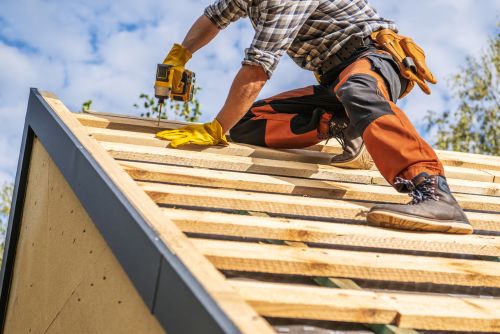
DIY roof construction is fun and rewarding. Building a roof yourself and seeing the results is very rewarding. Building a roof yourself can save you money and give you a sense of accomplishment, whether you need a new roof or just minor repairs.
Before starting your DIY roofing project, gather all the tools and materials. Nails, shingles, underlayment, flashing, and other roof design-specific supplies are included. Start with a solid plan and an understanding of the process. Tutorials and professional advice may also help.
When building the roof, safety is paramount. Make sure you have harnesses, helmets, and non-slip shoes. Avoid falls and accidents while working at heights. Follow local building codes to ensure your DIY roof meets professional standards.
Built correctly and safely, building your own roof can be rewarding. Complete the project on your own for unmatched satisfaction, but it may require some research and planning. In the next section of the 'homeowner's guide', remember that building your own roof is just one part of being a proactive homeowner who takes pride in their property.
As a homeowner, you need a complete guide to property maintenance and improvement. Roofs are important for home maintenance. A basic understanding of DIY roofing can save you time and money when installing or repairing a roof. This homeowner's guide to roofing has helpful information and tips to help you succeed.
When it comes to choosing the right roofing material for your home, there are numerous options available. From traditional asphalt shingles to metal roofs and even eco-friendly choices like solar tiles, each type has its own advantages and disadvantages. Understanding the characteristics of different materials will help you make an informed decision that suits your budget and preferences.
Safety should always be a top priority when working on any project around the house, especially when it involves heights. Before starting any DIY roofing project, make sure you have proper safety equipment such as harnesses, ladders with stabilizers, and non-slip shoes. Also, familiarize yourself with safety guidelines for working at heights to prevent accidents or injuries.
Over time, roofs may experience damage due to weather conditions or general wear and tear. Being able to identify common problems such as leaks, missing shingles, or damaged flashing can save you from costly repairs down the line. Knowing how to perform basic roof repairs can help extend the lifespan of your roof and maintain its integrity.
While some homeowners may feel confident in their ability to tackle DIY roofing projects, it's important to know when professional assistance is necessary. Certain tasks such as major roof replacements or complex structural repairs require expertise beyond what an average homeowner possesses. Recognizing your limitations and seeking professional help when needed ensures that the job gets done correctly.
Understanding these key points in our homeowner's roofing guide will prepare you for DIY roofing projects. We'll discuss the tools and materials needed for successful roof installations and repairs in the next section. With the right knowledge and tools, maintaining and improving your roof is easy and adds value to your home.
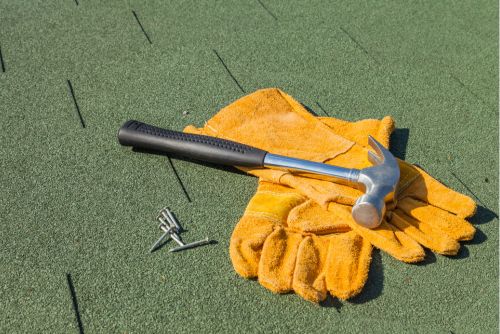
A smooth DIY roof replacement project requires the right tools and materials.
A ladder, hammer, utility knife, pry bar, and nail gun will help you remove old shingles, install new ones, and build a sturdy roof. Always wear gloves and safety glasses when working on your roof.
In addition to the right tools, a successful roofing project requires high-quality materials. High-quality shingles that can withstand harsh weather will last longer, as will an underlayment to prevent leaks, flashing, and sealant.
The sense of accomplishment that comes from completing a DIY roofing project on your own is truly rewarding, but some roofing techniques require expertise and experience to avoid costly mistakes or potential dangers. While homeowners can handle many aspects of their own roofing projects with confidence,
Moving on to 'roofing techniques', mastering these techniques is essential to a flawless DIY roof replacement project.
Your DIY roof replacement project will look great if you master various roofing techniques. It may seem difficult at first, but with the right tools, materials, patience, and determination, you can do it.
However, working on a roof can be dangerous if safety precautions aren't taken, so knowing the right roofing techniques is essential for a successful project.
Shingle installation is one of the most important roofing techniques. This involves aligning and fastening each shingle to ensure they're securely in place. Follow the manufacturer's overlap and positioning instructions. Using the right nails and driving them into the roof surface will help prevent leaks and shingle damage.
Flash installation protects chimneys, vents, and skylights from water infiltration. It takes precision to cut and shape flashing to fit snugly around these areas. Failing to do so can cause water damage inside your home.
For longevity and durability, your roof must be properly sealed by applying a waterproof sealant or adhesive under shingles or around edges where water may penetrate. Knowing which sealant is best for your roof material is crucial.
A successful DIY roof replacement project requires mastering various roofing techniques. While it may seem difficult at first, with practice and attention to detail, you can achieve professional-looking results. Always prioritize safety when working on a roof.
The next section, 'understanding your roof,' will cover different roof types and their characteristics without missing any steps in our quest to become DIY roofers.

To better understand your roof and assess if is it hard to roof your own house, especially if you're replacing it or doing DIY roofing work, learn about its unique features and characteristics.
Here are three important factors:
1. Roof Hazards: Before embarking on any roofing project, it's crucial to be aware of the potential hazards involved. Working at heights can be dangerous, and there's always a risk of falling or injury. Additionally, handling heavy materials like shingles or tiles may lead to strain on your body. It's important to take necessary safety precautions and use proper equipment such as harnesses, ladders, and gloves.
2. Roof Work Difficulty: Roofing can be physically demanding and challenging. Factors like steepness, slope complexity, and the presence of multiple levels can significantly impact the difficulty level of the task. A simple roof with a moderate pitch may be more manageable compared to a complex roof structure with various angles and corners. Assessing the difficulty level beforehand will help you determine whether DIY roofing is feasible for your specific situation.
3. DIY Roofing Considerations: While some homeowners may find joy in tackling home improvement projects themselves, it's essential to evaluate your skills and capabilities honestly. DIY roofing requires knowledge of construction techniques, familiarity with tools, and an understanding of local building codes. Additionally, keep in mind that mistakes during installation can lead to costly repairs down the line or even compromise the structural integrity of your home.
Understanding these factors will help you decide whether to DIY a roof or hire a contractor.
Consider the complexities of a DIY roofing project and learn how to efficiently complete this difficult task while maximizing your home's protective covering.
Roofing your own house can be rewarding with the right knowledge and preparation. But roofers must be aware of the risks and take precautions.
Before doing a DIY roof replacement or repair, learn about roof types and their needs. Knowing your roof's materials and lifespan will help you choose repairs or replacements. Check local building codes to ensure project safety. By knowing this, you can avoid costly mistakes and make your DIY roofing efforts successful.
DIY roofing safety is essential throughout the process. Work at heights is dangerous, so wear harnesses, helmets, and non-slip shoes. Before working on a roof, check the weather conditions. Strong winds and rain can cause accidents.
When doing DIY roof work, technique is crucial. Start by thoroughly cleaning your roof to remove debris that could impede repairs or installation. Use high-quality roofing tools for accurate measurements and secure fastening. Your product will be more durable and attractive after these steps.
As we discuss working safely on our own roofs in the next section, remember that with careful planning and attention to detail, you can complete this difficult project safely.
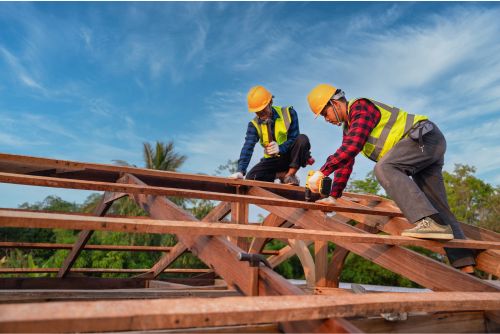
Working safely is paramount when doing DIY roofing. Taking precautions during roof work is crucial to your safety. I know how important safety is because I've roofed my own house and want to share some tips.
Always wear safety gear when working on a roof. This includes wearing sturdy, non-slip shoes or boots to avoid falls. A good harness system can also secure you to the roof while working. Safety gear is crucial because accidents can happen instantly.
Being aware of your surroundings is essential to roof safety. Note any loose shingles or debris that could cause you to slip or trip. Clearing these obstacles before starting your project reduces risks.
Also, check the weather before working on the roof. Working in high winds or bad weather increases accident risk. Prepare for calm weather before starting to ensure safety.
To further enhance your safety while working on a roof, it's important to communicate with others nearby who may be affected by your project. Inform family members or neighbors about your intentions so they're aware and can take necessary precautions themselves.
After covering some safety tips for DIY roofing projects, let's discuss the challenges you may face without missing a step!
DIY roofing projects can be difficult. Who said innovation was easy? Roof replacement, or any roof work, has risks and obstacles.
Injury is a major DIY roofing issue. Working at heights can be dangerous for beginners. To reduce risk, use proper safety precautions and equipment.
Doing your own roofing can also present unexpected issues. As you remove old shingles or inspect the structure, you may find hidden issues that need immediate attention. This could be rotten wood, water damage, or structural issues. These unexpected issues can delay and complicate your project.
DIY roofing can also be difficult for novices. There are many online and book resources for DIY, but nothing beats hands-on experience. Installation and leak prevention require precision and skill in roofing. Without training, it's easy to make costly mistakes.
DIY roofing is not for the faint-hearted. Heightwork is dangerous and can cause unexpected problems. Lack of experience can also hinder professional success. If you're willing to learn and overcome these obstacles, a DIY roof replacement can be financially and personally rewarding.
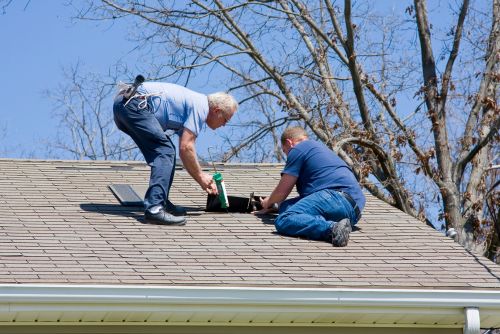
DIY roofing projects vary in cost, which is important to remember. Roof replacement or repair costs depend on project size, complexity, and materials. Damaged roofs or those that need specialized materials can be expensive.
Additional costs may include permits or hiring professionals for certain tasks. You must carefully assess your budget before starting DIY roof work.
DIY can be much cheaper than hiring contractors. You save money on labor and have more control over material prices by doing the work yourself. This lets you find high-quality, affordable options. To get the best deal, research suppliers and compare prices.
DIY roof projects can save a lot of money with proper planning and budgeting. Consider cost when deciding to do your own roofing, but don't overlook the risks. Working at heights is dangerous. Roof falls can cause serious injury or death. Use harnesses and ladders with stabilizers, and follow manufacturer and industry safety guidelines.
Before deciding if DIY roofing is right for you, weigh the costs and risks. It can save money and give you control over your home improvement project, but it requires research, planning, and safety.
Understanding these factors will help you decide if DIY roof work is right for you.
Consider DIY roofing's benefits when calculating roof replacement costs. This project may seem daunting at first, but doing it yourself has many benefits. Cost savings are the main benefit. DIY roofing can save you a lot of money compared to hiring a professional.
DIY roofing has benefits beyond saving money. Complete process control is a major benefit. Choose materials, design, and style that match your home vision. Customization can be very rewarding.
Another benefit of DIY roofing is the sense of accomplishment. You can feel proud and confident after completing such a difficult task on your own. Now you can prove to yourself that you can handle difficult projects and finish them.
Roof work is dangerous, especially if you're not familiar with safety protocols. Falling from heights is dangerous. Safeguards like safety harnesses and ladder placement guidelines can greatly reduce these risks.
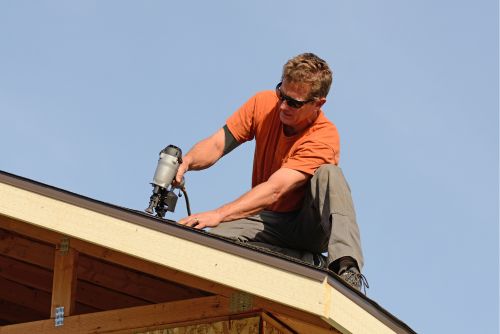
DIY roofing will show you how fast you can finish. Roof installation is time-sensitive, so doing it yourself lets you set your schedule. You can focus solely on roof work, unlike roofing professionals, who may have other obligations.
This efficiency lets you finish the project faster than if you hired someone. DIY roofing saves time and streamlines the process. Professional work often takes longer due to coordination between tradespeople or material delivery. As a DIY roofer, you have everything at your fingertips and can work at your own pace without outside interference. This efficiency ensures that every roof installation step is completed quickly and as planned.
DIY roofing allows for innovation and time savings. As DIY homeowners, we subconsciously want to show off our creativity and problem-solving skills. Rooftop projects are ideal for innovation because they require careful planning and execution. You can try different methods or materials to suit your needs or style. This freedom encourages new ideas and lets homeowners personalize their homes.
While there are many benefits to completing your own roofing project efficiently and creatively, it's important to consider potential risks before going into too much detail.
DIY roofing projects can present unexpected challenges and hazards. Without experience or safety gear, roof work is dangerous.
Falls from heights can cause serious injuries or death. Working with heavy materials like shingles and tools like hammers and nail guns increases the risk of accidents.
Another risk is structural damage. You could damage your roof or underlying structure if you replace it without proper knowledge and technique. Hiring a professional roofer could have prevented costly repairs.
Furthermore, weather risks must be considered. If you do your own roof work, you may face extreme heat, rain, wind, or storms. These conditions make the task harder and increase the accident risk.
DIY roofing projects can be rewarding and cost-effective, but they also pose risks. Falls from heights, structural damage, and bad weather are serious risks.
When deciding whether to replace your roof yourself or hire professionals, weigh these risks against your skills.

Hiring professionals for your roofing project can provide peace of mind and ensure safety and efficiency. It's tempting to replace your own roof, but consider the challenges.
Roof work is difficult and requires expertise. DIY roofing can create poor workmanship and endanger you and your property. Roof work is difficult, so hiring professionals is advised. Work at heights, lift heavy objects, and navigate complex roofing systems. Without proper training and experience, mistakes can damage your roof. Professionals can assess your roofing needs, choose the right materials, and install or repair it perfectly.
DIY roof replacement is dangerous and difficult. You risk falling or injuring yourself when climbing steep slopes or walking on slippery surfaces. Roofing also poses risks like electrical wires, unstable structures, and attic pests like bees and squirrels. Professional roofers have safety gear and protocols to reduce these risks.
Hiring professionals for your roofing project reduces risks and improves results. Their expertise ensures a smooth job from start to finish. Professional roofers also have access to high-quality materials and tools that DIYers may not.
Due to the difficulty and risks of DIY roof replacement, we recommend hiring a professional. DIY roofing has many success stories, despite its initial difficulty! These inspiring stories will give you hope as you work toward an innovative roofing solution.
Imagine finishing a roofing project on your own and standing atop your new shelter. Replacing your roof isn't as hard as it seems.
DIYers have excelled at this challenge. Three inspiring stories of people who completed their roofing projects with stunning results:
1. Tom, an avid DIYer, decided to replace his old worn-out roof by himself. He carefully researched the process, gathered the necessary tools and materials, and began his adventure. With determination and attention to detail, he followed each step meticulously.
Tom's hard work paid off when he completed the project ahead of schedule and saved a significant amount of money in the process.
2. Sarah, a single mother with limited financial resources, was faced with the daunting task of replacing her leaky roof. Hiring professionals seemed impossible due to budget constraints. However, Sarah refused to let her circumstances dictate her fate. She embarked on a journey to learn about roofing work from online tutorials and books available at her local library.
Despite initial doubts from friends and family, Sarah successfully replaced her roof by herself within a reasonable timeframe.
3. Mark had no prior experience in construction or home improvement when he decided to tackle his first roofing project solo. Armed with determination and an unwavering spirit of innovation, Mark approached the task with enthusiasm and eagerness to learn new skills. Through trial and error plus extensive research online, he overcame obstacles along the way until completion.
These success stories show that replacing your roof with proper planning and research is possible. Roofing work involves risks like falls and injury, but precautions can reduce them.
DIY roofing projects allow personal growth and save money on professional labor. Exploring new materials, techniques, and designs allows for innovation. Why not tap into your subconscious desire for innovation and build your own house? With determination, careful planning, and a little DIY spirit, you can transform your shelter and enjoy the satisfaction of completing such a major task.
Overall, roofing your own home is challenging but rewarding but is it hard to roof your own house? Roofs require planning, the right tools and materials, and roofing knowledge. Project completion is possible with efficiency and time management.
However, DIY roofing risks must be considered. Installation errors can result in costly repairs and make working at heights dangerous. You should also know when to hire professionals for more complicated roof installations or repairs.
While some homeowners have succeeded with DIY roofing, you should assess your skills, experience, and comfort with such a large project before deciding to do it yourself.
Roofing your own house can be exciting and empowering, but you must understand the risks. Without professional help, you may face problems that could cost you or injure you.
Falling from heights while doing roof work can cause serious injury. Inexperienced roofers may improperly secure materials, causing leaks and water damage.
Incorrectly installing flashing or ventilation components can weaken your roof and cause future problems. Finally, without safety protocols, you may accidentally encounter electrical hazards or other project hazards.
DIY projects allow for innovation and self-reliance, but you should weigh these risks against your skill level and consult roofing experts before starting.
Knowing when to hire professionals for your roofing project is essential to success and efficiency. As a creative person, I understand the desire to DIY, but there are times when professional help is needed.
First, if your roof is large or complex with multiple angles and slopes, hire experienced roofers who have the skills and tools for the job. Professionals can save you time and injury if you lack the time or physical ability to do this demanding task.
Moreover, hiring experts ensures quality materials and proper installation techniques that will prolong your roof and give you peace of mind. Finally, professional roofers are insured against project accidents and damages.
In conclusion, while innovation is admirable, calling in professionals for roofing work will result in a safer and more durable roof.
Homeowners have completed roofing projects successfully. There are many inspiring stories of innovative people who took on the challenge and succeeded.
One homeowner DIYed roofing to save money and express their creativity. They spent time studying roofing materials, methods, and safety. With this new knowledge, they carefully planned every step, from removing the old shingles to installing new ones.
With determination and a can-do attitude, they completed the process flawlessly. Their beautifully crafted roof gave them an indescribable sense of accomplishment and showed their creativity and resourcefulness.
Yes, roofing your own house takes effort and skill, but with the right mindset and preparation, you can succeed.
DIY roofing projects present many challenges. Removing and installing roof materials is physically demanding. Working in uncomfortable positions, climbing ladders, and carrying heavy tools and materials can be physically demanding.
Understanding a roofing system's complexities and ensuring proper installation can be difficult for beginners. Working on a roof in extreme heat or cold is dangerous and difficult.
Finally, getting permits and following safety rules complicates the project. Despite these obstacles, with careful planning, research, and determination, you can finish your own roofing project for less money and more satisfaction.
By doing the job yourself, you can control the materials and workmanship, ensuring your roof is built to your exact specifications.
When considering whether to tackle a DIY roofing project or hire professionals, cost considerations play a crucial role.
Opting for the DIY route can save you money as you won't have to pay for labor costs. Additionally, purchasing materials yourself allows you to compare prices and potentially find more affordable options.
However, it's important to factor in the potential risks involved in roofing your own house. Mistakes can be costly and may require further repairs down the line.
So while there are potential cost savings in doing it yourself, it's essential to weigh them against the challenges and risks that could arise during the project.